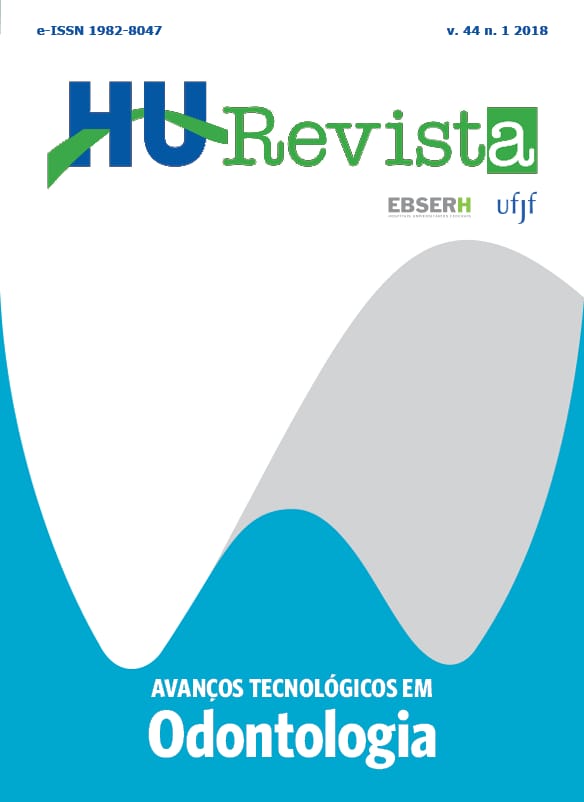Uso de métodos não invasivos para avaliação da espessura muco-gengival: a tecnologia a favor do diagnóstico
DOI:
https://doi.org/10.34019/1982-8047.2018.v44.13952Palavras-chave:
Gengiva, Mucosa bucal, Tecido conjuntivo, Tomografia computadorizada de feixe cônico, Ultrassonografia, Imagem por ressonância magnética.Resumo
O objetivo no presente estudo foi realizar uma revisão atualizada da literatura sobre os diferentes métodos não invasivos utilizados para avaliação da espessura muco-gengival. O biotipo gengival é considerado um dos principais elementos de influência no resultado do tratamento estético. Pacientes com gengiva espessa demonstram ser mais resistentes à recessão gengival após terapia cirúrgica e/ou restauradora. Em contrapartida, pacientes com biotipo fino apresentam maior risco de recessão, sendo necessário, muitas vezes, o enxerto de tecido conjuntivo. O palato é a principal área doadora para enxerto de tecido conjuntivo subepitelial, sendo que a determinação da espessura da mucosa palatina é de grande importância para a previsibilidade dos procedimentos cirúrgicos. Existem diversos métodos para mensurar a espessura muco-gengival, alguns considerados invasivos, como: a avaliação transgengival (ou transmucosa); e outros, mais recentes, considerados não invasivos, como as imagens seccionais de ultrassom, tomografias computadorizadas ou imagens de ressonância magnética. Apesar de diversos estudos demonstrarem resultados positivos do uso de exames por imagens para avaliação da espessura dos tecidos muco-gengivais, concluiu-se que os métodos invasivos ainda parecem ser os mais utilizados.
Downloads
Referências
AMID, R. et al. Assessment of gingival biotype and facial hard/soft tissue dimensions in the maxillary anterior teeth region using cone beam computed tomography. Archives of Oral Biology, v. 79, p. 1-6, jul. 2017.
BARRIVIEIRA, M. et al. A new method to assess and measure palatal masticatory mucosa by cone-beam computerized tomography. Journal of Clinical Periodontology, v. 36, n. 7, p. 564-568, jul. 2009.
CARRANZA, F. A. et al. Periodontia Clínica. 10. ed. Rio de Janeiro: Guanabara Koogan, 2007.
DE ROUCK, T. et al. The gingival biotype revisited. Transparency of the periodontal probe through the gingival margin as a method to discriminate thin from thick gingiva. Journal of Clinical Periodontology, v. 36, n. 5, p. 428-433, may. 2009.
FISCHER, K. R. et al. Gingival biotype revisited-novel classification and assessment tool. Clinical Oral Investigations, v. 21, n. 1, p. 443-448, jan. 2018.
GUPTA, P. et al. Accuracy of cone-beam computerized tomography in determining the thickness of palatal masticatory mucosa. Journal of Indian Society of Periodontology, v.19, n. 4, p. 396-400, jul./ago., 2015.
GÜRLEK, Ö. et al. A novel soft tissue thickness measuring method using cone beam computed tomography. Journal of Esthetic and Restorative Dentistry, 2018 Nov 15. doi: 10.1111/jerd.12428. [Epub ahead of print].
HEIL, A. et al. Determination of the palatal masticatory mucosa thickness by dental MRI: a prospective study analysing age and gender effects. Dentomaxillofacial Radiology, v. 47, n. 2, p. 20170282, feb. 2018.
JANUÁRIO, A. L.; BARRIVIERA, M.; DUARTE, W. R. Soft tissue cone-beam computed tomography: a novel method for the measurement of gingival tissue and the dimensions of the dentogingival unit. Journal of esthetic and restorative dentistry, v. 20, n. 6, p. 366-373, 2008.
MALHOTRA, R. et al. Analysis of the gingival biotype based on the measurement of the dentopapillary complex. Journal of Indian Society of Periodontology, v. 18, n. 1, p. 43-47, jan. 2014.
MANJUNATH, R. G.; RANA, A.; SARKAR, A. Gingival biotype assessment in a healthy periodontium: transgingival probing method. Journal of Clinical and Diagnostic Research, v. 9, n. 5, p. ZC66-69, may. 2015.
MÜLLER, H. P. et al. Thickness of masticatory mucosa. Journal of Clinical Periodontology, v. 27, n. 6, p. 431-436, jun. 2000.
PARMAR, R. et al. Determination of soft tissue thickness at orthodontic miniscrew placement sites using ultrasonography for customizing screw selection. American Journal of Orthodontics and Dentofacial Orthopedics, v. 150, n. 4, p. 651-658, oct. 2016.
RAJPOOT, N. et al. Evaluation of variation in the palatal gingival biotypes using an ultrasound device. Journal of Clinical and Diagnostic Research, v. 9, n. 3, p. ZC56-60, mar. 2015.
RAMESH, K. et al. Assessment of thickness of palatal masticatory mucosa and maximum graft dimensions at palatal vault associated with age and gender – a clinical study. Journal of Clinical and Diagnostic Research, v. 8, n. 5, p. ZC9-13, may. 2014.
SILVA, J. N. N. et al. Influence of lip retraction on the cone beam computed tomography assessment of bone and gingival tissues of the anterior maxilla. Oral Surgery, Oral Medicine, Oral Pathology and Oral Radiology, v. 123, n. 6, p. 714-720, jun. 2017.
SONG, J. E. et al. Thickness of posterior palatal masticatory mucosa: the use of computerized tomography. Journal of Periodontology, v. 79, n. 3, p. 406-412, mar. 2008.
STEIN, J. M. et al. The gingival biotype: measurement of soft and hard tissue dimensions - a radiographic morphometric study. Journal of Clinical Periodontology, v. 40, n. 12, p. 1132-1139, dec. 2013.
UENO, D. et al. Palatal mucosal measurements in a Japanese population using cone-beam computed tomography. Journal of Esthetic and Restorative Dentistry, v. 26, n. 1, p. 48-58, jan./feb. 2014.
YAMAN, D. et al. Thickness of palatal masticatory mucosa and its relationship with different parameters in Turkish subjects. International Journal of Medical Sciences, v. 11, n. 10, p. 1009-1014, jul. 2014.
YILMAZ, H. G.; BOKE, F.; AYALI, A. Cone-beam computed tomography evaluation of the soft tissue thickness and greater palatine foramen location in the palate. Journal of Clinical Periodontology, v. 42, n. 5, p. 458-461, may. 2008.
YOUNES, F. et al. Relationship between buccal bone and gingival thickness revisited using non-invasive registration methods. Clinical Oral Implants Research, v. 27, n. 5, p. 523-8, may. 2016.
Arquivos adicionais
Publicado
Como Citar
Edição
Seção
Licença
Cessão de Primeira Publicação à HU Revista
Os autores mantém todos os direitos autorais sobre a publicação, sem restrições, e concedem à HU Revista o direito de primeira publicação, com o trabalho licenciado sob a Licença Creative Commons Attribution que permite o compartilhamento irrestrito do trabalho, com reconhecimento da autoria e crédito pela citação de publicação inicial nesta revista, referenciando inclusive seu DOI.









